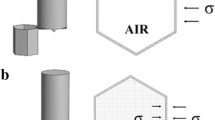Abstract
This paper presents the first comprehensive investigation that aluminum honeycomb has inevitable machining defect in milling process, such as deformation, burr, and collapse. Ice fixation method was used to clamp workpieces, and inner-injection liquid nitrogen was employed for a series of cryogenic milling machining. In the machining process, the main machining parameters including in honeycomb orientation, milling width, cutting depth, cutting speed, and feed were executed experimental research. Meanwhile, the machining parameter optimization, range, and significant analysis were adopted to analyze the influence of machining parameters on the machining surface quality, as well as the optimal parameter combination and milling machining surface quality were predicted and verified. The results show that the ice fixation aluminum honeycomb method with cryogenic milling is much advanced than that of conventional ones, and many machining defects are effectively restrained. At the same time, the influence of machining parameters on machining qualities in descending order is cutting depth, cutting speed, honeycomb orientation, feed, and milling width. The minimum roughness value (Ra = 0.356 μm) of the predicted machining surface is similar to the actual machining result (Ra = 0.362 μm). It verifies the feasibility of the optimization method. Furthermore, it is proved that the ice fixation + liquid nitrogen cooling method has a positive effect on the high milling quality and implement efficiency for aluminum honeycomb and other difficult-to-machine materials.
Similar content being viewed by others
References
Botelho EC, Silva RA, PardiniL C et al (2006) A review on the development and properties of continuous fiber/epoxy/aluminum hybrid composites for aircraft structures. Mater Res 9(3):247–256
Hassan MR, Scarpa F, Mohamed NA (2009) In-plane tensile behavior of shape memory alloy honeycombs with positive and negative Poisson’s ratio. J Intell Mater Syst Struct 20(8):897–905
Lee TH, Sim MS, Joo SH (2016) Effect of intermetallic compound thickness on anisotropy of Al/Cu honeycomb rods fabricated by hydrostatic extrusion process. Trans Nonferrous Metals Soc China 26(2):456–463
Zhao CQ, Zhao YJ, Ma J (2017) The stability of new single-layer combined lattice shell based on aluminum alloy honeycomb panels. Appl Sci Basel 7(11):1150–1161
Barekar NS, Dhind BK (2014) Twin-roll casting of aluminum alloys – an overview. Mater Manuf Process 29(6):651–662
Ding M, Zhang PL, Zhang ZY (2010) A novel assembly technology of aluminum alloy honeycomb structure. Int J Adv Manuf Technol 46(9–12):1253–1258
Pervaiz S, Rashid A, Deiab I (2014) Influence of tool materials on machinability of titanium – and aluminum alloys: a review. Mater Manuf Process 29(6):219–252
Wang ZD (1999) The cryogenic mechanical properties of high TC132 alloy. Cryogenics 5:27–30
Li XD, Zhou CP, Qiu JH (2014) Mechanical considerations for unfolded honeycomb milling. Fiber Reinforced Plastics/Composites 6:70–73
Jin CZ (2005) Study on high speed machining process and reliability of fixture method for NOMEX honeycomb. Doctor degree thesis of Zhejiang University:56–83
Luo JW, Gao T, Mu WP (2014) Nomex honeycomb bore clamping method by ultrasonic machine. Aeronaut Manuf Technol 22:106–109
Huang CK, Li BT (2006) Quality study of honeycomb core shaping without wax stabilization. Mater Manuf Process 21:81–86
Ma C, Liu FJ (2016) Research progress in processing technology of honeycomb materials. Aeronaut Manuf Technol 3:48–54
Antony MD, Prakash A, Jagannatha Guptha VL (2012) Influence of cell size on the core shear properties of FRP honeycomb sandwich panels. Mater Manuf Process 27:169–176
Gibson LJ, Ashby MF (1999) Cellular solids: structure and properties. Cambridge university press, Cambridge, pp 34–201
Abbadi A, Koutsawa Y, Carmasol A, Belouettar S, Azari Z (2009) Experimental and numerical characterization of honeycomb sandwich composite panels. Simul Model Pract Theory 17(10):1533–1547
Attard MM, Hunt GW (2008) Sandwich column buckling-a hyperelastic formulation. Int J Solids Struct 45(21):5540–5555
Kardomateas G A, Simitses G J(2004) Comparative studies on the buckling of isotropic, orthotropic, and sandwich columns. Mech Adv Mater Struct11(4):309–324
Kardomateas GA, Simitses GJ, Shen L, Li R (2002) Buckling of sandwich wide columns. Int J Non Linear Mech 37(7):1239–1247
Ajdari A,Nayeb-Hashemi H, Vaziri A(2011) Dynamic crushing and energy absorption of regular, irregular and functionally cellular structures. Int J Solids Struct48:506–516
Zarei MM, Sadighi M (2011) A theoretical and experimental study on metal hexagonal honeycomb crushing under quasi-static and low velocity impact loading. Mater Sci Eng 528(A):4958–4966
Zhang LC, Zhang HJ, Wang XM (2001) A force prediction model for cutting unidirectional fibre-reinforced plastics. Mach Sci Technol 5(3):293–305
Wang FB, Liu JK, Li LL, Shu QL (2017) Green machining of aluminum honeycomb treated using ice fixation in cryogenic. Int J Adv Manuf Technol 92:943–952
Jeyakrishnan PR, Chockalingam KSK, Narayanasamy R (2013) Studies on buckling behavior of honeycomb sandwich panel. Int J Adv Manuf Technol 65:803–815
Zhao X, Zhang Q, Chen D (2010) Enhanced mechanical properties of graphene-based poly (vinyl alcohol) composites. Macromolecules 43(5):2357–2363
Yu Y(2013) Research on mechanical properties of metal honeycomb sandwich plate. Doctor degree thesis of Harbin Institute of Technology:20–45
Mendoza MM, Eman KF (1983) Development of a new milling cutter for aluminium honeycomb. Int J Mach Tool Manu 23(3):81–91
Chen K (1996) Design and analysis of experiments. Tsinghua University press, Beijing, pp 94–184
Mei CL (2006) Practical statistical methods. Science press, Beijing, pp 218–242
Gogte CL, Likhite A, Peshwe D, Shett R (2014) Effect of cryogenic processing on surface roughness of age hardenable AA6061 alloy. Mater Manuf Process 29(6):710–714
Yoshimitsu M (1984) Characteristics and application of aluminum alloys at cryogenic temperature. R&D Kobe Steel Eng Rep 34(3):67–75
Ribeiro SM, de Oliveira JA, Arruda EM (2016) Analysis of burr formation in form tapping in 7075 aluminum alloy. Int J Adv Manuf Technol 84(5–8):957–967
Funding
This research was partially supported by the basic science and research project of Liaoning province (No. LG201711), the Liaoning key fund of national natural science fund (No. U1608251), and the Natural Science Foundation Project of Liaoning Province (No. 20170540787).
Author information
Authors and Affiliations
Corresponding author
Rights and permissions
About this article
Cite this article
Wang, F., Wang, Y. Optimization of cryogenic milling parameters for aluminum honeycomb treated by ice fixation method. Int J Adv Manuf Technol 99, 2271–2281 (2018). https://doi.org/10.1007/s00170-018-2599-0
Received:
Accepted:
Published:
Issue Date:
DOI: https://doi.org/10.1007/s00170-018-2599-0



